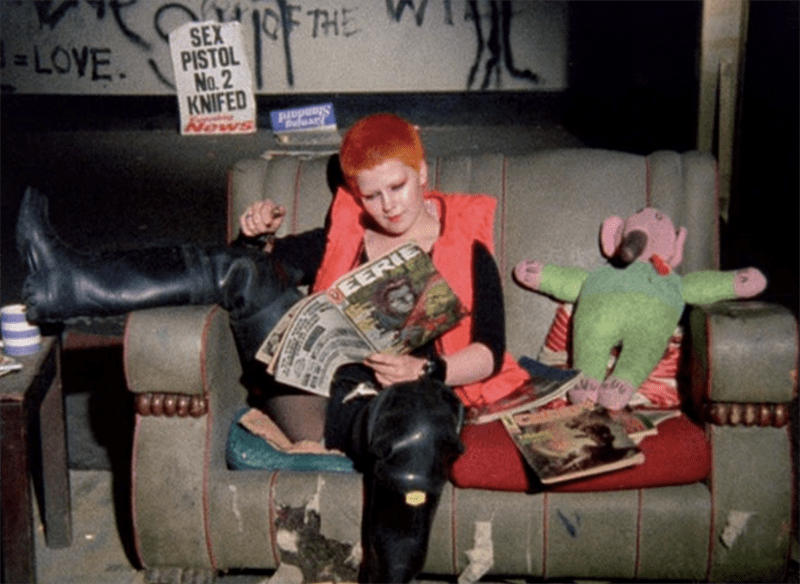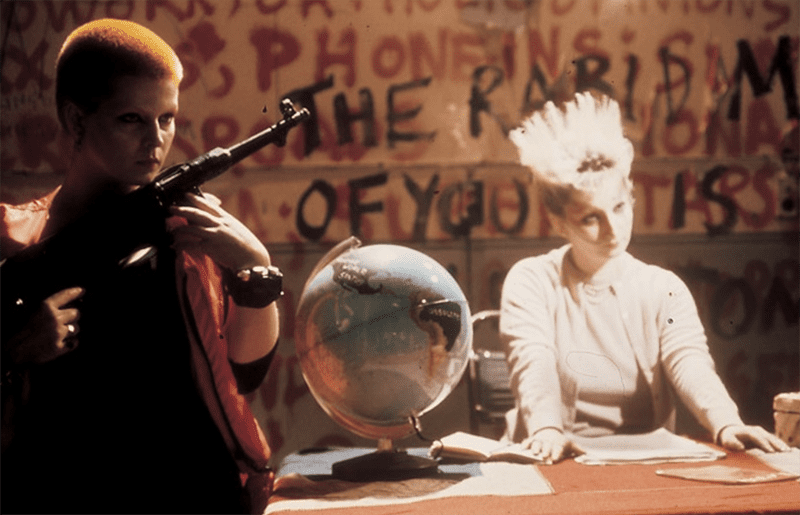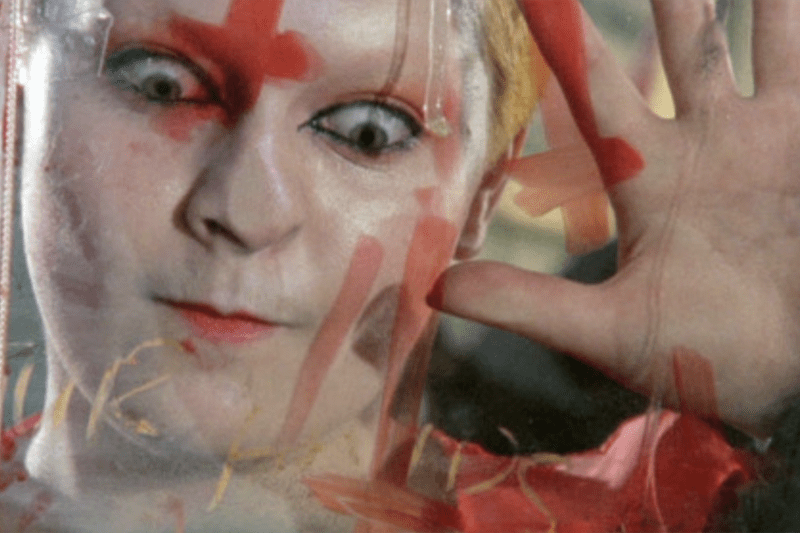
In the late ’70s Britain was a grey, bleak, and financially depressed place. As such, disaffected and disenfranchised pockets of the country’s working class youth were able to relate directly to the acerbic and nihilistic observations about the state of the nation that were made by emergent punk rockers such as the Sex Pistols’ Johnny Rotten. Tapping directly into this mood, Derek Jarman‘s vision of contemporary Britain in Jubilee is – for the most part – suitably drab, barren and desperate.
However, Jubilee‘s Britain is set in an alternate reality or an imagined near future in which further political and financial calamity has edged the country closer to a truly dystopian state of affairs. High inflation, rising unemployment, and a general sense of hopelessness that led to real hardships and angry social protests in late ’70s Britain have progressed to such levels that a breakdown in law and order has occurred. By day, gangs of punks roam the deserted streets committing violent acts that the police choose to ignore. By night, armed and corrupt Special Branch officers harass, beat, and execute young punks on sight.
Within this violent milieu, we’re introduced to a commune of vaguely punk-ish characters. Bod (Jenny Runacre) is a lupine sophisticate who leads the gang and becomes its queen after stealing the crown jewels; Mad (Toyah Willcox), who sports close-cropped and dyed-orange hair is a cynical and aggressive tomboy who usually has a deadly weapon of some description close to hand. Both are militant celibates, and this sometimes puts them at odds with their promiscuous housemate, the outgoing actress-cum-groupie Crabs (Little Nell). The trio seemingly settles their differences by killing Crabs’ latest lover, Happy Days (Gene October), when he fails to fully satisfy Crabs in bed.
Amyl Nitrite (Jordan) is a retro style-obsessed daydreamer who spends her time writing an abridged and revisionist history of the world. Also along for the ride are two easy-going brothers, Sphinx (Karl Johnson) and Angel (Ian Charleson), who enjoy an incestuous relationship while also being partial to seducing female and male partners and bedding them together. A silent French au pair, Chaos (Hermine Demoriane), attends to the gang’s domestic needs.
All told, they’re hardly a sympathetic bunch and it’s little wonder that most punk spectators found little to relate to in the film, character-wise, at the time of its release. Jubilee‘s marketing made it look like a timely film about a controversial contemporary youth culture. However, Jubilee is really an alternative / art house feature that utilises the trappings of punk. When compared to contemporaneous youth culture flicks such as Franc Roddam’s Quadrophenia (1979) or gang culture films such as Walter Hill’s The Warriors (1979), Jarman’s film doesn’t offer much in the way of a traditional narrative.

Jubilee can be broken down into three key sections. Its first section focuses primarily on Amyl Nitrite who gets to present her provocative and psychopathic personal philosophies via a lecture to a captive audience of punk women and an interior monologue that plays over shots of her in the gang’s warehouse home. Both of her deliveries contain exposition that offers insight into the state of the nation while also serving to formally introduce each member of the gang.
The little sense of pace and flow that this section possesses is interrupted by an overlong avant-garde interlude that shows Amyl ballet dancing amidst a surreal mise-en-scene (Jarman produced quite a number of short films and this footage is taken from one such film, Jordan’s Dance from 1977). There’s also a scene where Mad reads sections from the revisionist Teach Yourself History book that Amyl is writing. For the most part, there’s a very stagey, amateur street theatre and filmed play-like feel present in this early portion of the film.
The pace picks up somewhat in the film’s middle section, which introduces a more obviously cinematic feel to the proceedings. This section details the main characters’ relationships with an all-powerful media mogul, Borgia Ginz (Orlando). This is perhaps the most interesting and relevant part of the show as Jarman’s vision of a world where just one man might effectively control a country – and, by extension, the world’s money markets – by virtue of his complete control of the media has particular resonance today. Similarly, Ginz’s observation that “this is the generation who grew up and forgot to lead their lives. They were so busy watching my endless movie” seems to predict the distracting power of reality TV, the Internet, social media and so on.

Each female member of the gang plays their cards close to their chests when dealing with Ginz and it’s implied that he’s the one individual who might be able to get them to sell each other out. But they have no respect for Ginz’s product and employees. Finding themselves bored one night, the girls elect to kill Ginz’s top-selling star, Lounge Lizard (Wayne County). By contrast, Angel and Sphinx seem less enamoured with Ginz. The boys come on like savvy representatives of working-class folk culture and they advise Kid to resist entering the popular music industry.
The film’s final portion has Angel and Sphinx succumbing to a nighttime attack by Special Branch officers, which leads to Bod, Mad, Crabs, and Amyl hitting the vengeance trail. While Jubilee‘s middle and final sections do possess a more straightforward sense of narrative, they’re both quite episodic.
Jubilee also features a rather neat and clever framing device in which Queen Elizabeth I (Jenny Runacre, again) and her occult aide John Dee (Richard O’Brien) are transported to the future so that the monarch can see what will become of her country. The preliminary scenes set in Elizabeth I’s time are presented in the style of a very well realised historical drama. The pair is always one-step behind the chaos that Bod and company cause and the monarch is perplexed and appalled by the misery that the gang leaves in their wake and the general decline of the nation.
At the time of Jubilee‘s production Jarman was primarily known for the outstanding set design work that he had done for Ken Russell’s The Devils (1971) and for directing his debut feature, Sebastiane (1976). Both films had sparked a fair amount of controversy in the UK after outraging the country’s moral guardians. In 1977, the country’s moral guardians were busy again thanks to the moral panic that was initiated by Britain’s emergent punk rock subculture and the release of the Sex Pistols’ ‘God Save the Queen’ single during the year of Queen Elizabeth II’s silver jubilee celebrations.

Jarman had worked on a short film about the Sex Pistols – Sex Pistols Number 1 (1977) – so Jarman and punk must have felt like a natural fit of sorts, even if the director was not part of the movement, per se. In her interview in the disc’s extra features Jordan reveals that she played a crucial role in suggesting to Jarman which punk personalities might be best suited to appear in Jubilee.
Much like his former colleague Ken Russell and, for that matter, punk provocateurs such as Vivienne Westwood and Malcolm McLaren, Jarman knew precisely which buttons to press when seeking to outrage the UK’s moral majority. But much of Jarman’s modus operandi here is fairly predictable. Jubilee is a veritable mix of nudity, sex, and violence that’s embellished by plenty of anti-establishment posturing and purposefully offensive bits of business that are topped off with a touch of blasphemy.
While this heady mix does result in a very distinctive film, its unsympathetic characters and pointedly outrageous set-pieces led to many interested parties viewing Jubilee as a mischievous exercise in adding fuel to the moral panic surrounding punk rather than a much needed attempt to objectively document the movement and present a sympathetic understanding of the socio-political moment that it was born out of. Indeed, Vivienne Westwood was reportedly disgruntled enough to design a t-shirt that actively criticised Jarman and the film. It would be easy to dismiss Jubilee as being an opportunistic mess but, with auteurs like Jarman, the default presumption is that everything onscreen is intentional and everything has some kind of meaning.
This outlook is certainly reflected in the interviews included on the BFI’s new disc in which both Jordan and Toyah Willcox confirm that Jarman encouraged a range of acting styles on set for some kind of artistic effect: Jordan was allowed to go at it in an obviously non-professional manner while Willcox – appearing in her first film – was given free rein to do as she wished with her part. Willcox would quickly mature into a decent enough actor but her approach here – kind of channelling aspects of Johnny Rotten (the intense stare, the sneering attitude, and the insolent diction) – goes a little over the top at times. She’s pretty convincing in the film’s revenge orientated final chapter.

By contrast, established actors such as Jenny Runacre and Little Nell were seemingly directed in a more conventional manner and they deliver more nuanced performances. The effect is quite jarring when any combination of the four female actors cited above appear onscreen together but it kind of works – so much so that Karl Johnson and Ian Charleson’s turns as the male gang members are somewhat overshadowed by their female counterparts. Jubilee‘s four main female protagonists all get to reveal some pretty grotesque and monstrous aspects of their personalities.
Ginz is a particularly grotesque character, too. The media mogul is brought to life in a spirited and uninhibited manner by Orlando (AKA Jack Birkett). Orlando was a member of Lindsay Kemp’s theatre company and Kemp and his troupe also appear in the film. A self-styled philosopher who has hit the ultimate winning streak, Ginz gets to deliver some of the film’s best dialogue. Adam Ant’s performance as the quiet wannabe punk star Kid fluctuates between that of a non-professional and that of a slightly more experienced performer. The show is probably stolen by Wayne County’s brief-but-wild turn as the exuberant hit-maker Lounge Lizard.
Regarding tone and style, Jubilee possesses a range of different and sometimes jarring approaches. Its introductory section is more art house and experimental in nature, featuring a fairly loose approach to camera set-ups and pacing. Efforts are made to keep the film on an art house / alternative footing in both the middle and final sections of the show, but the subject matter seemingly demanded nods in the direction of exploitation and cult cinema too. There are times when the activities of the intensely violent, motorbike riding female foursome found here bring to mind characters found in ’60s exploitation films such as Russ Meyer’s Faster, Pussycat… Kill! Kill! (1965) and Herschell Gordon Lewis’ She-Devils on Wheels (1968).
The scene featuring Wayne County’s cross-dressing Lounge Lizard at home in his kitschy living room briefly gives the film the look and feel of a John Waters movie with County coming on like a cross between Divine and Gerrit Graham’s camp Glam rocker Beef from Brian De Palma’s The Phantom of the Paradise (1974). It’s saying something when the avaricious, self-obsessed but happy to stay at home Lounge Lizard comes across as probably being the film’s most sympathetic character.
Jubilee is also a highly intertextual show: Amyl refers to her liking of a song from co-star Richard O’Brien’s musical The Rocky Horror Show; the words scrawled on the back of the gang’s matching jackets reference Alfred Hitchcock’s Psycho (1960) and Crabs refers to her (or, rather, Little Nell’s) recent acting gig in British TV’s ace music business related series ‘Rock Follies of ’77’ (1977).
So is there anything of interest here for anybody seeking a “punk” movie as such? On the soundtrack, art rocker Brian Eno supplies minimalist but effective ambient synthesizer cues that rub shoulders with a couple of found classical music pieces, which are probably as un-punk as can be. Jordan is an obvious point of interest as she worked at Westwood and McLaren’s shop SEX and was an easily recognised member of the Sex Pistols’ entourage. When auditioning for Ginz, Jordan’s Amyl Nitrite character mimes to Suzi Pinns’ operatic rock-cum-reggae interpretation of ‘Rule Britannia’. Similarly, Toyah performs the Maneaters’ ‘Nine to Five’ when Mad auditions for Ginz while Adam and the Ants perform ‘Plastic Surgery’ when Kid undergoes the audition process.
Wayne County’s Lounge Lizard character sings along in his living room when Wayne County and the Electric Chairs’ ‘Paranoia Paradise’ is broadcast on his TV. The Slits appear briefly as an all-girl street gang that smashes an abandoned car and Chelsea’s Gene October plays Crabs’ unfortunate lover, Happy Days. A scene where Bod and company are supposedly watching ‘Top of the Pops’ features snippets of performances by Siouxsie and the Banshees and Chelsea that are shot directly from the gang’s cruddy television set’s screen.
Helen Wellington-Lloyd, who was another easily recognised associate of Malcolm McLaren and the Sex Pistols, plays Elizabeth I’s lady in waiting. She went on to appear in Julien Temple’s Sex Pistols’ vehicle The Great Rock ‘n’ Roll Swindle (1980). Jarman loads Amyl Nitrite’s thoughts in the early portion of the film with purposefully offensive opinions that chime with punk’s early desire to shock at any cost and the film more generally is chockfull of the kind of nihilistic attitudes that went hand in hand with punk’s formative years. Johnny Rotten’s assertion of there being “no future” is invoked at one significant point in the film.
The picture and sound quality of the BFI’s Blu-ray presentation of Jubilee are both excellent but the show itself remains a tough film to evaluate. It feels like it somehow doesn’t quite deliver whatever it was supposed to. Jubilee‘s central conceit regarding a dystopian Britain controlled by a media mogul undoubtedly offers much food for thought. There are interesting cult figures aplenty here too, and some of the film’s set pieces work really well. Indeed, there are odd moments here where apt music and stylish and striking visuals combine to produce fleetingly transcendent sequences that bring to mind similarly successful audio-visual synergies that are found in the likes of The Phantom of the Paradise, Jim Sharman’s The Rocky Horror Picture Show (1975) and Ken Russell’s Tommy (1975). Jubilee would have benefitted greatly from a few more instances of this kind of approach.
By contrast, there are sequences (particularly early on) that drag a little and almost get lost in their search for a loose, semi-improvisational and slightly anti-classical style of filmmaking. Most of the additional films cited in this review have become recognised as cult movies that have enjoyed afterlives as objects of fascination within fan circles that sit outside of the mainstream. As such, Jubilee might be most appreciated by those who are able to embrace its cult movie aspects. Its enigmas and failings may not always be as compelling or as endearing as those found in the best-known cult films but some of Jubilee‘s idiosyncratic content does work to position the film squarely within the wild terrain of the cult film corpus.
It might well be that Jubilee‘s chief failing – as far as mainstream assessment strategies go – lies in the fact that it employs the aesthetics – and busies itself with the thematic concerns – of two conflicting and irreconcilable modes of filmmaking: the art house and the grindhouse. And yet, if we consider that British punk was itself similarly conflicted – with its learned architects dabbling in arty mischief and Situationist pranks, while its street kid practitioners were often more concerned with directly articulating issues relating to social inequality and exclusion – it could be that Jarman succeeded in making a film whose conflicted content might well be described on one level as being decidedly “punk”.
While the standalone interviews with Jordan, Toyah Willcox and Lee Drysdale (who worked behind the scenes on the film) are interesting and welcome, it feels like the BFI are selling Jubilee a little short in its approach to extra features here. The film features a significant cast and crew, was the work of a significant director, and was born out of a significant moment in Britain’s socio-political history. That in theory sets Jubilee up as being a potentially significant (if flawed) film that demands to be properly contextualised in a critical manner. As such, this release feels like a missed opportunity to produce a fully-fledged “making of” (or similar) documentary featuring a wider pool of new and archives-sourced interviews. It feels like there’s a fascinating story to be told here. A story that would undoubtedly provide new insights into Jubilee‘s perceived failings.
The BFI possesses some interesting punk-related short films and documentaries that would have helped to partly contextualise some of Jubilee‘s content but the only video extra feature included here is A Message from the Temple (1981), a five-minute film by Psychic Television that features Jarman. An image gallery contains costume design sketches and production stills. A slim (16 pages) booklet features two contemporary reviews of Jubilee, a half-page ‘Jubilee Revisited’ piece by William Fowler and a useful five-page overview of Jarman’s career by Jason Wood.


![Call for Papers: All Things Reconsidered [MUSIC] May-August 2024](https://www.popmatters.com/wp-content/uploads/2024/04/all-things-reconsidered-call-music-may-2024-720x380.jpg)



